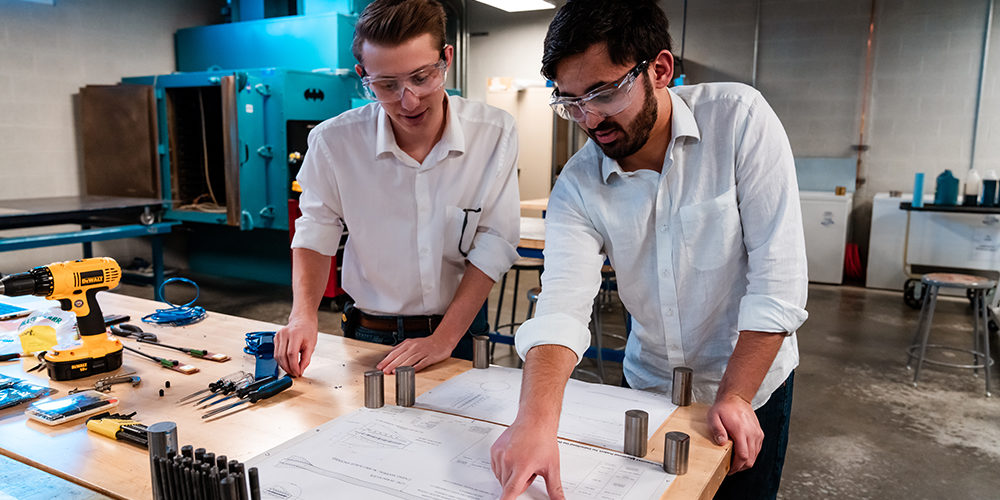In 2020, Rod Moore (’89), a retired naval officer, got an unexpected call. Would he be interested in joining a Philanthropy Council at Embry-Riddle’s College of Engineering in Prescott? The alumnus with a bachelor’s in Aeronautical Engineering and master’s in Civil Engineering agreed.
He was recovering from a traumatic brain injury. “I didn’t know it at the time, but I was looking for purpose again,” he said.
He says the experience lit a fire under him. In addition to giving $2,000 a year for three years — split between scholarships and student projects in the college — council members choose student projects to fund while engaging and mentoring the students.
“When I got a chance to start reviewing all these projects, I got really excited again — and then to actually ask questions and have a chance to interact with the students is probably the most rewarding part of it. And to share our experiences as council members with them, and to have them give their perspectives and ask question — that kind of engagement was really the most important part of the council, whether or not the projects got funded.”
The Funded Project that Lit the Fire
One of the projects that did get funded that Moore remembers most strongly is a team of students working on a suborbital reusable vehicle. Since 2018, a group of students has been aiming to create a fully reusable rocket that would reach an altitude of 100 km at hypersonic speed. This is a relatively new area in college programs, and this group of students is aiming to establish a lower cost to make this kind of project more accessible to other students.
In fall 2020, they had a week to prepare to pitch their project to a new Philanthropy Council panel. They were awarded funding and then again in 2021, receiving approximately $8,000 in support from the council.
At a recent test flight in the Mojave Desert, the rocket cleared the launchpad reaching Mach 2. But a problem with the structure ended the flight prematurely. The team is investigating and aiming for their official maiden launch.

“It’s about doing the hard things and pushing the boundaries — that is why we are trying to get to space,” said Gaurav Nene, the project’s principal investigator and a senior in Aerospace Engineering from Seattle. “And as far as we know, only one other university has successfully done this with a student-built rocket.”
Nene said the support from alumni on the Philanthropy Council since its inception has helped their nascent project, which includes three other members: David Hadley, a junior in Mechanical Engineering on the Robotics track from Seattle; William Knoblauch, a junior in Mechanical Engineering on the Propulsion track from San Antonio, Texas; and Cooper Eastwood, a senior in Aerospace Engineering from Los Angeles.
The financial support from the council is bringing their project to the finish line, Eastwood says.
“That large chunk of funding really put us in place to get this project all the way through so all four of us can see this through the end — so we can actually accomplish our goal of getting into space. Those alumni, they’ve been with us throughout two years now. And they’ll be able to see our progress.”
It’s the encouragement that has proved invaluable, according to Nene.
“I know for our team it feels like we are taking a community of alumni along the ride with us,” Nene says. “I feel like there is a unique sense of community when we talk about our progress every year with them. We know them by name, we know their stories and they know ours.”
A Rising Trajectory
Excited by his interaction with these students and others, Moore says that Philanthropy Council activities allow alumni to reflect on, “Where does Embry-Riddle fit in my trajectory?”
For Moore, that trajectory with Embry-Riddle is onward and upward. Since being involved with the council, he’s been inspired to become even more involved. He made a gift to the dean to support professional development. And he and his wife, Amy, created an endowed scholarship, including a planned gift, to create a legacy that contributes to future student success.
What started for Moore as a commitment to council service has now grown into a realization that such service can change lives — including his own.
“I have an opportunity to serve again — and that’s what I’ve missed is serving,” he says. “This was a way on the council to serve and to further Embry-Riddle’s reputation, to get a chance to be an amplifier for education, for service — and in my personal case, to be an amplifier for perseverance, overcoming obstacles and paying it forward.”
